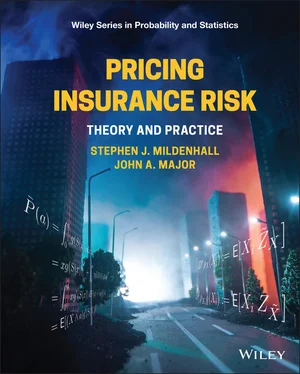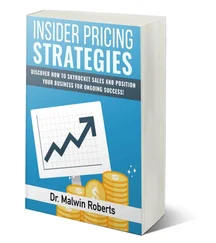Stephen J. Mildenhall - Pricing Insurance Risk
Здесь есть возможность читать онлайн «Stephen J. Mildenhall - Pricing Insurance Risk» — ознакомительный отрывок электронной книги совершенно бесплатно, а после прочтения отрывка купить полную версию. В некоторых случаях можно слушать аудио, скачать через торрент в формате fb2 и присутствует краткое содержание. Жанр: unrecognised, на английском языке. Описание произведения, (предисловие) а так же отзывы посетителей доступны на портале библиотеки ЛибКат.
- Название:Pricing Insurance Risk
- Автор:
- Жанр:
- Год:неизвестен
- ISBN:нет данных
- Рейтинг книги:4 / 5. Голосов: 1
-
Избранное:Добавить в избранное
- Отзывы:
-
Ваша оценка:
- 80
- 1
- 2
- 3
- 4
- 5
Pricing Insurance Risk: краткое содержание, описание и аннотация
Предлагаем к чтению аннотацию, описание, краткое содержание или предисловие (зависит от того, что написал сам автор книги «Pricing Insurance Risk»). Если вы не нашли необходимую информацию о книге — напишите в комментариях, мы постараемся отыскать её.
A comprehensive framework for measuring, valuing, and managing risk Pricing Insurance Risk: Theory and Practice
Pricing Insurance Risk: Theory and Practice
Pricing Insurance Risk — читать онлайн ознакомительный отрывок
Ниже представлен текст книги, разбитый по страницам. Система сохранения места последней прочитанной страницы, позволяет с удобством читать онлайн бесплатно книгу «Pricing Insurance Risk», без необходимости каждый раз заново искать на чём Вы остановились. Поставьте закладку, и сможете в любой момент перейти на страницу, на которой закончили чтение.
Интервал:
Закладка:
Having computed technical premiums as distorted expected values, we can then apply the same distorted probabilities to unit losses, based on their co-occurrence with the total portfolio losses, to allocate the premiums to units. This technique provides a high degree of consistency and synchronization in calculating technical premiums by unit.
There is a particular approach to handling business unit performance assessment and reinsurance decision making that makes use of a capital measure, typically VaR or TVaR, but appears not to make use of a pricing metric. This approach is rooted in return on risk-adjusted capital style financial logic. It takes two steps: allocate capital and then assign a cost of capital hurdle rate that every unit must meet on its allocated capital. All decisions, such as reinsurance purchases, use the same cost of capital as a benchmark.
Practitioners recognize that this approach tends to place uncomfortably large burdens on catastrophe exposed units relative to units that do not participate much in solvency threatening events. In addition, when applied to reinsurance purchasing, it tends to favor, almost without exception, deals that operate at high levels of loss with low probabilities. We show that the problem here stems from the implicit use of what we call the Constant Cost of Capital (CCoC) SRM. The overall hurdle rate for the entire portfolio may not be appropriate for every unit. What is needed is a pricing risk measure— different from CCoC—that responds to varying levels of riskiness with different required rates of return. Whereas Part II discusses the construction of such measures, Part III discusses how to deploy them.
1.3.4 Part IV: Advanced Topics
The last part of the book touches on five topics that go beyond the coverage of previous chapters: asset risk, reserves, going concern and franchise value, reinsurance optimization, and portfolio optimization.
1.3.5 Further Structure
Parts II and III divide portfolio pricing from allocation considerations. Within each part, we further distinguish classicalfrom modernapproaches, and theoryfrom practice. The hierarchy, reflected in the sequence of eight core chapters, is:
Chapters 8and 9: classical portfolio pricing theory and practice,
Chapters 10and 11: modern portfolio pricing theory and practice,
Chapters 12and 13: classical price allocation theory and practice, and
Chapters 14and 15: modern price allocation theory and practice.
Our dividing line between classical and modern is 1997, the average publication date of three highly influential papers. Relating to Part I: Artzner et al. (1997) introduced coherent risk measures and revolutionized thinking about measuring risk. Relating to Part II: Wang (1996) introduced the premium density and developed the theory of pricing by layer. And, relating to Part III: Phillips, Cummins, and Allen (1998) rigorously derived financial prices in a multiline company accounting for default. The classical versus modern bifurcation serves a convenient organizational purpose but should not be taken too seriously.
Classical pricing is predominantly actuarial and risk theoretic. A stability requirement, often linked to the probability of eventual ruin, determines required assets. There is no direct consideration of the cost of capital. On the other hand, modern approaches combine risk theory with financial and mathematical economics and decision science. They relate risk to the investors’ return and the cost of capital and pay attention to uncertainty and risk under pooling. They leverage powerful mathematics to understand intuitively reasonable risk measures.
1.4 What’s in It for the Practitioner?
This book is intended to be a practitioner-friendly reference as well as providing a theoretical framework. Our methods must have a firm theoretical foundation to justify their real world application. Many topics are inherently technical and require a mathematical background to understand fully. At the same time, the methods we describe can and should be implemented in practice. We have structured the book so readers eager to get their hands dirty can do that more easily. Throughout Parts II and III, we alternate theoretical and practical chapters. The Practice chapters present a range of simple numerical examples and apply all the methods we propose to three realistic Case Studies.
We also pay more attention to institutional arrangements—the way things get done—than the typical theoretical presentation. Different forms of capital, capital compared to equity, accounting, and the mechanism of default, especially equal priority, all play essential roles. Furthermore, we address certain standard practices in the industry and subsume them within our analytical framework so the reader can better appreciate their properties and behavior.
Over the years we have found that putting these tools and techniques into practice raises the following questions.
Which risk measure should I use?A common followup question asks if the risk measure should be sensitive to the tail of the distribution or volatility in the body, which translates into a concern about solvency vs. quarterly earnings. As always in modeling, the measure must be appropriate to the intended purpose. Our framework separates the amount of capital from its cost: the capital risk measure is necessarily tail focused, whereas the pricing risk measure captures investor return expectations. Additionally, the connection between capital structure and the pricing risk measure is a fundamental insight.
How do I reconcile and manage different economic and regulatory views of risk?Often followed by, “Who cares? We manage to [Rating Agency’s] capital model”. We agree: you don’t care. The rating agency model is a binding constraint on the amount of capital for many insurers. You control the form and influence the cost of capital. Again, two risk measures. It isn’t a question of reconciliation; it is a question of understanding each measure’s distinct purposes.
Should pricing target a return on all capital, or can there be excess capital?Genuinely excess capital is exceptionally rare. Our model produces a cost of capital specific to each company, which varies with the amount of capital. A better capitalized company has a lower percentage cost of capital, other things being equal, because higher layer capital is less stressed and exposed to risk. As a result, the problem of applying a uniformly high cost of capital, producing uneconomic premiums, should not occur. The frictional costs of capital are, however, constant for all layers of capital. Indeed, they could be increasing if the management of overcapitalized companies has an incentive to engage in frivolous, self-aggrandizing activities.
How do I determine the cost of capital? Does it vary by unit?The risk cost of capital is the weighted average cost over the actual capital used. Debt and reinsurance have known costs. The cost of equity capital is normally estimated using a peer study. The cost of capital varies by unit according to which capital layers each unit consumes. The frictional cost of capital typically does not vary by unit.
Can risk margins ever be negative?Classical and modern approaches to pricing are unanimous that the risk margin must be positive for the portfolio. However, negative margins are appropriate for some units within the portfolio. They occur for units that are hedges, with losses arising more in situations where the portfolio has lower losses and less when the portfolio has more significant losses. The common practice of paying a positive margin for ceded reinsurance proves the point: the outward cash flow (premium) is greater in expectation than the inward cash flow (recovery). Looking at expectations makes reinsurance seem inappropriate, but the key to the value of reinsurance (or any hedge) is when those cash flows occur.
Читать дальшеИнтервал:
Закладка:
Похожие книги на «Pricing Insurance Risk»
Представляем Вашему вниманию похожие книги на «Pricing Insurance Risk» списком для выбора. Мы отобрали схожую по названию и смыслу литературу в надежде предоставить читателям больше вариантов отыскать новые, интересные, ещё непрочитанные произведения.
Обсуждение, отзывы о книге «Pricing Insurance Risk» и просто собственные мнения читателей. Оставьте ваши комментарии, напишите, что Вы думаете о произведении, его смысле или главных героях. Укажите что конкретно понравилось, а что нет, и почему Вы так считаете.












